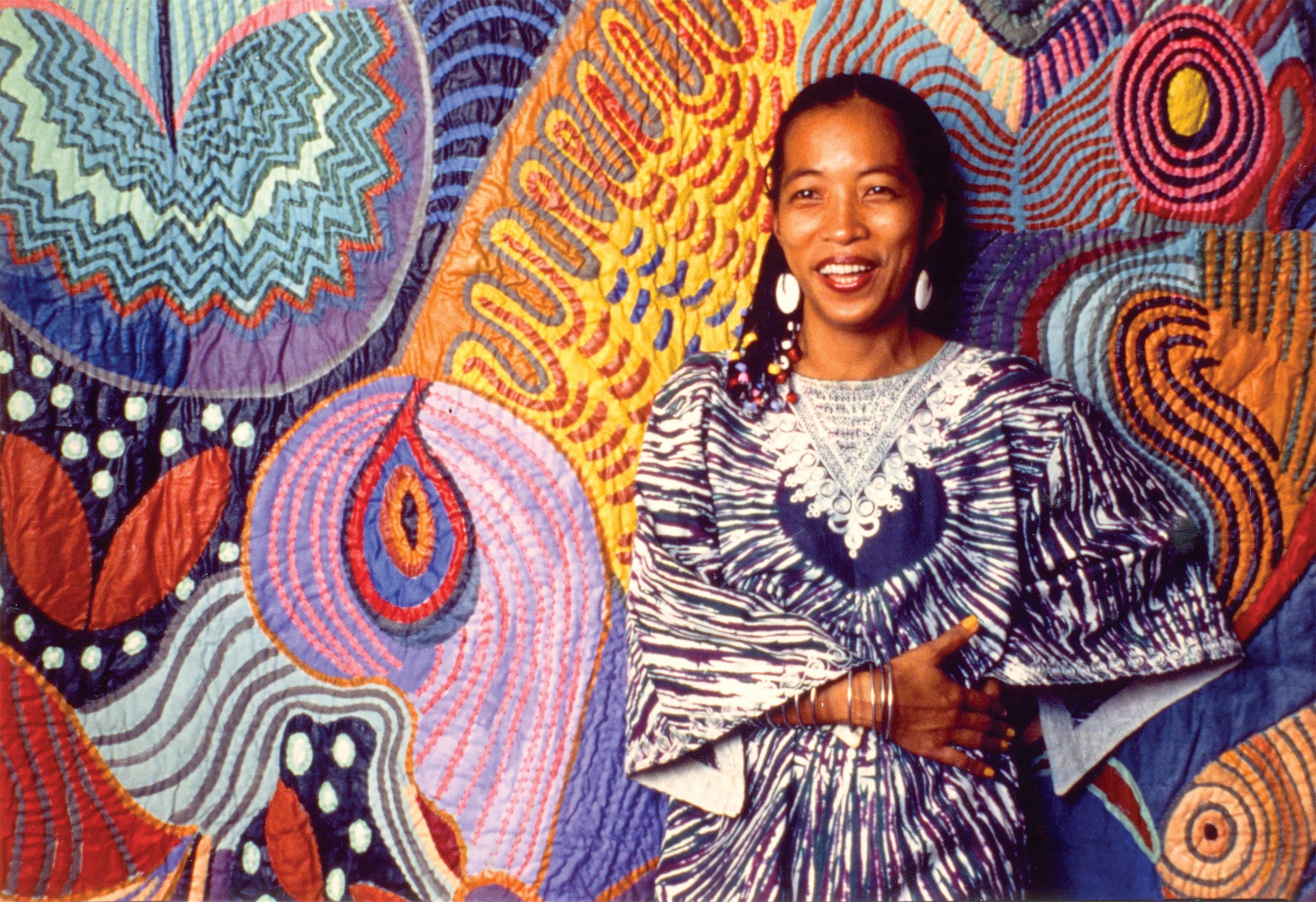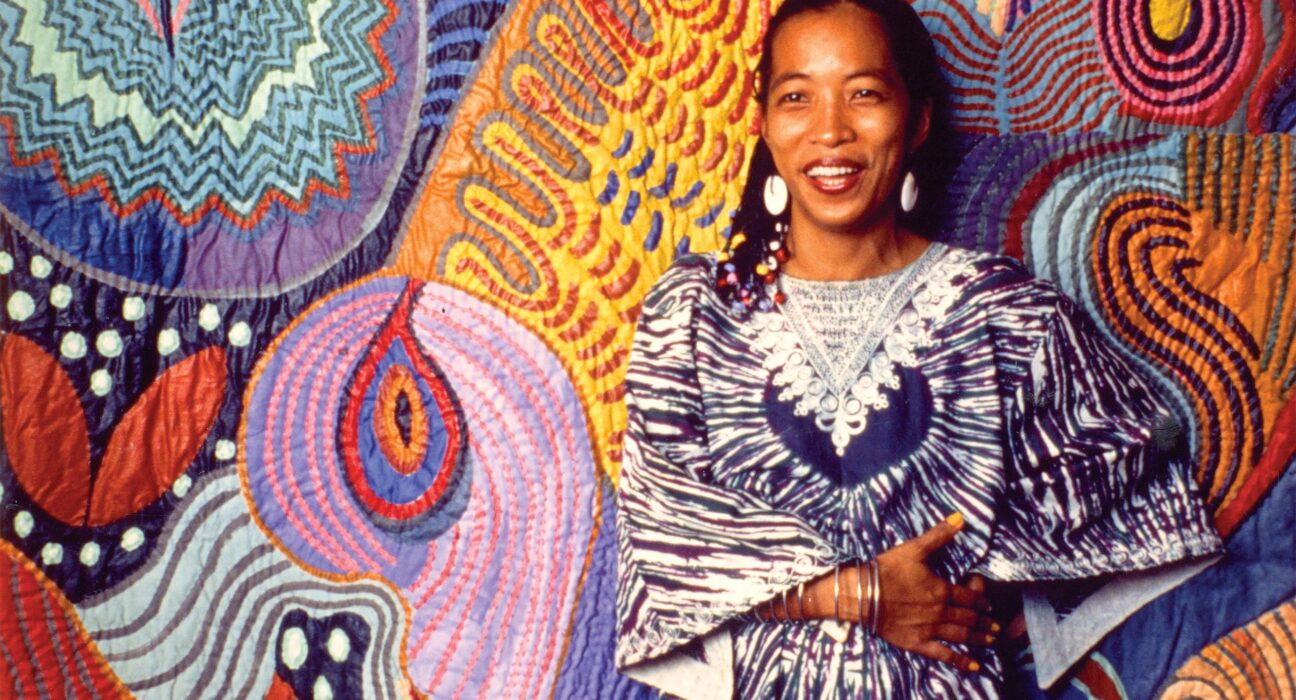
In 1970, 24-year-old Pacita Abad left her home in the Philippines, fleeing political persecution after leading a student protest against the Marcos regime. She was planning to study law in Spain. Instead, she wound up in San Francisco, an intended one-day visit with an aunt changing the course of her life.
In the years that followed, Abad became a talented artist. She developed a vibrant and luminous style that was entirely her own. Her signature trapunto paintings were richly colorful and embellished quilted canvases inspired by textile traditions from around the world. Until her premature death from lung cancer in 2004, Abad worked prolifically, creating some 5,000 works over a 32-year period.
Now, roughly 40 of those pieces, which engage with issues of race, immigration, and feminism, are finally getting their moment in the sun. Abad’s long-overdue first career retrospective, organized by the Walker Art Center in Minneapolis, is currently on view at the San Francisco Museum of Modern Art.
“The exuberance of her work is one of the first things that people notice. They see the colors, the patterns, and how wild so much of the work is. It’s the exact opposite of Minimalism,” Nancy Lim, SFMOMA’s associate curator of painting and sculpture, said in a video interview. “The material and visual seductions of her work are undeniable.”
Pacita Abad, If My Friends Could See Me Now (1991). Collection of the San Francisco Museum of Modern Art, purchase, by exchange, through a gift of Peggy Guggenheim. Photo by Don Ross, courtesy of the artist’s estate.
The exhibition, which will travel to MoMA PS1 in New York and Toronto’s Art Gallery of Ontario next year, is poised to be a well-deserved breakthrough moment for Abad. Despite an extensive exhibition history, the artist remains a fairly obscure figure in 20th century art history. (Her auction record, set in June 2022, is just ₱9,344,000, or $176,063, according to the Artnet Price Database.)
Personally, I had seen a handful of the artist’s work at art fairs, courtesy of New York’s Tina Kim Gallery, but still found the show to be a revelation when I encountered it at the Walker over the summer.
Each room was painted a different vibrant color, in keeping with the way the artist and her second husband, Jack Garrity (who now manages her estate), decorated their homes around the world. Starting with a year-long trip across Asia in 1973, the two spent time in some 60 countries thanks to his career as a World Bank economist.
Pacita Abad, European Mask (1990). Collection of the Tate Modern, London, purchased with funds provided by the Asia Pacific Acquisitions Committee 2019. Photo by At Maculangan/Pioneer Studios, courtesy of the artist’s Estate and Tate Modern.
The works, many of them monumental, invite close examination with their profusion of different materials. Despite little formal art training, Abad effortlessly mixed oil and acrylic paints with a wide variety of adornments, from plastic buttons, beads, and rhinestones to cowrie shells, fringe, and mirrors, working on padded canvas.
“Pacita immersed herself in artisan communities wherever she was traveling, studying material culture wherever she went,” Lim said. “It was through textiles that she learned about abstraction, about color, about patterning, about all of these things that she ended up incorporating into her aesthetic sensibility.”
Her influences included Burmese and Indian embroidery, Indonesian batik, Nigerian tie-dye, and Korean ink brush painting, as well as indigenous mask traditions from across the globe.
Portrait of Pacita Abad at work in her Manila studio in 1984. Photo courtesy of the artist’s estate.
But her itineracy also prevented her from establishing roots in any one community, which helps in part to explain her relative obscurity. (And that’s to say nothing of the racism and sexism Abad faced in dismissals of her work as ethnic, feminine, or decorative—all too common for a woman embracing traditions of craft.)
“She was kind of everywhere and nowhere at once,” Lim said. But when exhibition curator Victoria Sung, now the senior curator at the Berkeley Art Museum and Pacific Film Archive, first approached SFMOMA about the traveling show, the museum jumped at the chance to put Abad in the spotlight.
“Pacita’s creative origins are in San Francisco. Her family has often described San Francisco as her spiritual and artistic home, because this is where she first got the idea to become an artist,” Lim said.
It was a brief first marriage to local artist George Kleiman that introduced Abad to the city’s artistic milieu. And the city’s activist movements, such as the Black Power Movement, expanded Abad’s political awareness. (Her parents were both politicians, and their many children were actively involved in their campaigns.)
Pacita Abad, My fear of night diving (1985). Collection of the Lopez Museum and Library, Manila, Philippines. Photo courtesy of the artist’s estate and Lopez Museum and Library.
Abad’s later work would respond to such world events as the 1992 Los Angeles riots, the Haitian refugee crisis, and Mexican migrants’ detention at the U.S. border. Other pieces appear less obviously tied to politics, like her “Underwater Wilderness” series featuring gorgeous aquatic scenes of coral reefs, which contains references to Spain’s colonization of the Philippines. This range complicated the reception of Abad’s work.
“People would not understand why some works would seem very political, and then suddenly she appeared to be making a left turn to create other bodies of work that are apolitical,” Lim said. “Pacita was a slightly mysterious and confusing figure for a lot of people.”
Nearly 20 years after her death, however, the artist’s appeal is now instantly apparent in Abad’s must-see retrospective. As she put it herself, when asked in 1991 to summarize her contribution to American art, “Color! I have given it color!”
See more from the show below.
“Pacita Abad” at SFMOMA. Photo courtesy of SFMOMA.
“Pacita Abad” at SFMOMA. Photo courtesy of SFMOMA.
“Pacita Abad” at SFMOMA. Photo courtesy of SFMOMA.
“Pacita Abad” at SFMOMA. Photo courtesy of SFMOMA.
“Pacita Abad” at the Walker Art Center, Minneapolis. Photo courtesy of the Walker Art Center.
“Pacita Abad” at the Walker Art Center, Minneapolis. Photo courtesy of the Walker Art Center.
“Pacita Abad” at the Walker Art Center, Minneapolis. Photo courtesy of the Walker Art Center.
“Pacita Abad” at the Walker Art Center, Minneapolis. Photo courtesy of the Walker Art Center.
“Pacita Abad” at the Walker Art Center, Minneapolis. Photo by Eric Mueller, courtesy of the Walker Art Center.
Pacita Abad, (1998). Collection of the collection Walker Art Center, Minneapolis; T.B. Walker Acquisition Fund, 2022. Photo by Max McClure, courtesy of the artist’s estate and Spike Island, Bristol.
Pacita Abad, 100 Years of Freedom: Batanesto Jolo (1998). Photo by Chunkyo In, courtesy of the artist’s estate.
Pacita Abad, Marcos and His Cronies (1985–95). Collection of the Singapore Art Museum. Photo courtesy of the artist’s estate and the Singapore Art Museum.
Pacita Abad, Flight to Freedom (1980). Collection of the National Gallery Singapore. Photo courtesy of the artist’s estate and the National Gallery Singapore.
Pacita Abad, Spring Is Coming (2001). Photo courtesy of the artist’s estate.
Pacita Abad, Anilao at its Best (1986). Photo by At Maculangan/Pioneer Studios, courtesy of the artist’s estate and MCAD Manila.
“Pacita Abad” was on view at the Walker Art Center, 725 Vineland Place, Minneapolis, Minneapolis, April 15–September 3, 2023; and is at the San Francisco Museum of Modern Art, 151 Third Street, San Francisco, California, October 21, 2023–January 28, 2024. It will travel to MoMA PS1, 22-25 Jackson Ave, Queens, New York, April 4–September 2, 2024; and the Art Gallery of Ontario, 317 Dundas Street West, Toronto, Ontario, Canada, October 12, 2024–January 19, 2025.
More Trending Stories:
Art Dealers Christina and Emmanuel Di Donna on Their Special Holiday Rituals
Stefanie Heinze Paints Richly Ambiguous Worlds. Collectors Are Obsessed
Inspector Schachter Uncovers Allegations Regarding the Latest Art World Scandal—And It’s a Doozy
Archaeologists Call Foul on the Purported Discovery of a 27,000-Year-Old Pyramid
The Sprawling Legal Dispute Between Yves Bouvier and Dmitry Rybolovlev Is Finally Over
Follow Artnet News on Facebook:
Want to stay ahead of the art world? Subscribe to our newsletter to get the breaking news, eye-opening interviews, and incisive critical takes that drive the conversation forward.

